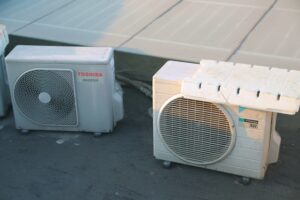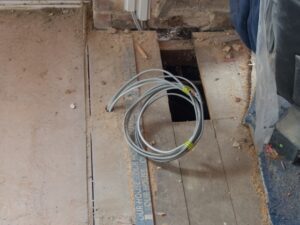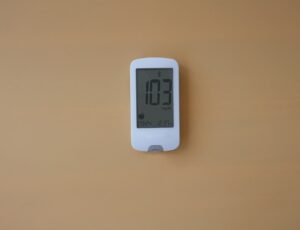Dealing with old caulking around your bathtub can be a real eyesore.
Over time, it cracks, peels, and turns discolored, making your bathroom look tired and outdated.
But don’t worry; removing old caulk doesn’t have to be complicated. With the right tools and a little elbow grease, you can restore your bathtub’s appearance and prevent water damage by replacing the old caulking with a fresh, waterproof seal.
So, what’s the first step?
Start by softening the caulk. You can do this with a store-bought caulk remover or something as simple as vinegar! Once softened, grab a scraper to peel away the old caulk. It’s as easy as that!
But if you’re hesitant about taking on the task yourself, or if things get tricky, calling in a pro can save you time and stress. At Excel Mechanical, we specialize in plumbing solutions that are as effective as they are budget-friendly. We’re not just about fixing a problem — we make sure your bathroom works perfectly and lasts for years.
Whether you’re working on a DIY project or need professional help, we’re here to make sure things go smoothly.
In this blog, you will learn:
- How to assess the condition of your old bathtub caulking.
- Step-by-step instructions for safely removing and replacing the old caulking.
- How to apply new caulk for a clean, long-lasting seal.
Let’s get started!
Understanding Caulking in Bathrooms
Caulking is essential for keeping bathrooms free from water damage. It creates a seal between surfaces like the tub and tiles, preventing water leaks. Mold and mildew can develop without proper caulking, leading to structural damage.
Caulking types include silicone, latex, and acrylic.
- Silicone is waterproof and flexible, good for bathrooms.
- Latex is easier to apply and paintable but not as resistant to water.
- Acrylic offers a balance of flexibility and ease but may not last as long in wet conditions.
Regular inspection is essential.
Check for cracks, peeling, or gaps. These signs mean it might be time to replace the caulking. When you find issues, act quickly to prevent costly water damage.
Replacing old caulking includes tools like a utility knife, a caulk softener, and a caulking gun. A steady hand ensures a clean, smooth finish. Proper preparation, such as cleaning the area and removing all old caulk, is key to success.
Safety Precautions and Preparation
Before removing old caulking from your bathtub, ensure you’re prepared with the right tools and gear. It’s essential to consider safety and ensure you have plenty of ventilation.
Protective Gear
Wearing the right protective gear is essential.
Use safety goggles to protect your eyes from debris and rubber gloves to shield your hands from chemicals and sharp tools. If you’re sensitive to strong fumes, you might also want to wear a mask.
A long-sleeved shirt and pants can protect your skin from potential scrapes or chemical exposure. Properly dressed, you stay safe and make the job more comfortable.
Select items that are easy to move in so you can work effectively without restrictions.
Ventilation and Environmental Concerns
Good ventilation is crucial.
Open windows or doors to allow fresh air to circulate while you work, which helps reduce the concentration of fumes from cleaners and solvents. If you have an exhaust fan, turn it on to help move the air around.
Maintaining air movement can make a big difference in keeping the environment safe. Avoid working in small, closed spaces. It keeps the air breathable and minimizes health risks associated with inhaling chemical fumes.
Materials and Tools Needed
Gather these materials: a utility knife or razor scraper for cutting through old caulk, a caulk remover tool, and plastic or wooden spatulas to scrape without damaging surfaces. A cleaning solution or mineral spirits will help remove any residue.
Paper towels or soft cloths are useful for wiping away debris. A trash bag is handy to collect removed caulk. Having everything ready ensures a smoother process from start to finish.
Assessing the Caulking Condition
- Start by examining the color and texture of the caulking around your bathtub. If it appears discolored, cracked, or peeling, it might need to be replaced. Mold or mildew stains indicate that the caulking is too old to be effective.
- Next, check for gaps between the caulking and the bathtub or walls. Water can seep through these gaps, causing damage to surfaces and structures. Press gently along the caulk line to make sure it’s secure. Loose or squishy spots mean the seal is compromised.
- Observe for leaks or water stains nearby. This could suggest that the caulking is not doing its job. If you notice any dampness or watermarks, removing and replacing the old caulking might be time.
- Performing a regular assessment of your bathroom caulking is essential. It helps ensure that your bathroom remains sealed and protected from water damage.
By closely monitoring the condition of your caulking, you’ll maintain the integrity of your bathroom’s fixtures.
Removing the Old Caulk
Removing old caulk from your bathtub involves specific manual techniques or chemical solvents. These methods ensure that the surface is clean and ready for new caulking, which is essential for preventing water damage and maintaining the appearance of your bathtub.
Manual Removal Techniques
Start by softening the caulk with a hairdryer or warm towel.
This makes it more pliable and easier to work with. Carefully cut along the edges with a utility knife or caulk removal tool. Work slowly to avoid damaging the tub surface.
After cutting along the edges, gently pull up the caulk strip with needle-nose pliers. For stubborn pieces, use a putty knife to scrape them away. Wipe the area with alcohol or a vinegar solution to remove all residue.
This step is crucial for ensuring that the new caulk adheres properly.
Chemical Solvents and Caulk Removers
Chemical solvents can simplify the caulk removal process.
Apply a caulk remover gel or spray directly to the old caulk. Allow it to sit for the time specified on the product label, usually about 20-30 minutes.
Once the solvent has softened the caulk, use a plastic scraper to remove the loosened material. Chemical solvents may be necessary for silicone and other persistent caulking materials. Always follow the product instructions for safe use. Ventilate the area well and wear gloves to protect your skin.
Remember, when dealing with complex plumbing and HVAC tasks, Excel Mechanical is your best option. We provide exceptional quality and great value, tailoring services to meet individual needs and budgets.
Cleaning and Prepping the Surface
To begin, gather your materials. You’ll need a cloth, mild soap, and a plastic scraper. Ensure your workspace is well-lit and free of clutter.
Safety first: wear gloves to protect your hands.
- Start by wiping the area with a damp cloth and mild soap. This will remove any dirt or loose particles. Rinse the area thoroughly and let it dry completely to prevent mold growth.
- Use a plastic scraper to remove the remaining caulk. Be gentle to avoid damaging the bathtub surface. Apply even pressure and scrape in one direction.
- After scraping, inspect the surface. You can use a small amount of caulk remover if any residue remains. Follow the instructions on the remover carefully. Wipe away any excess with a clean cloth.
- Once the caulking is completely removed, clean the area with soap and water. Allow it to dry fully before applying new caulking. This ensures a smooth application and a secure seal.
Applying the New Caulk
Applying new caulk correctly is essential to prevent water leaks and mold growth. Selecting the right type of caulk and mastering the application technique ensures a successful, long-lasting seal.
Choosing the Right Caulk
Selecting the right caulk is critical, as different types serve various purposes.
- Silicone caulk is perfect for non-porous surfaces like ceramic or metal. It is durable and flexible, making it ideal for bathrooms.
- Acrylic latex caulk is another option for easy application and cleanup. It is less flexible than silicone but paintable and suitable for areas that won’t expand. Ensure the caulk is waterproof and mold-resistant.
Consider the color and finish to match your bathroom. Some caulks are clear, while others come in various shades to blend seamlessly with surfaces.
Choosing the right formula ensures longevity and effectiveness.
Caulking Techniques for a Watertight Seal
Using the proper technique is key to creating a watertight seal.
Begin by cutting the nozzle at a 45-degree angle for a bead of the right size. Load the caulk into a caulk gun and apply even pressure to release a smooth, consistent line.
Slowly drag the caulk gun along the seam. A steady pace ensures a neat application. Use a wet finger or tool to smooth and push it into gaps, enhancing adhesion. Clean any excess caulk immediately with a damp cloth.
To avoid compromising the seal, allow the caulk to cure for the recommended time before using the bathtub.
Finishing Touches and Curing
After you’ve removed the old caulking and applied the new sealant, you’re almost done. A few finishing touches are left to ensure your bathtub looks and performs perfectly.
First, smooth the new caulk. Use a wet finger or a caulk-smoothing tool. This helps achieve a neat line and ensures the sealant adheres properly. Wipe away any excess with a damp cloth.
Checklist for Smoothing Caulk:
- Use a wet finger or tool
- Remove excess sealant
- Clean any smudges immediately
Next, allow the caulk to cure. Most products require at least 24 hours without exposure to water. Check the product instructions for specific curing times. Keeping the area dry is crucial for the sealant to bond effectively.
During the curing process, avoid using harsh cleaning products. This protects the new sealant from damage and ensures it lasts longer. Open a window or use a fan for ventilation to speed up drying.
Curing Tips:
- Avoid moisture
- Follow drying times
- Use ventilation to help
Maintenance Tips for Newly Caulked Surfaces
To keep newly caulked surfaces in great condition, follow these simple tips:
- Regular Cleaning: Clean the surface with mild soap and water. Avoid harsh chemicals that can damage the caulk. Regular cleaning prevents mold and mildew buildup.
- Inspect Frequently: Inspect the caulking for cracks or separation every couple of months. Early detection of issues can extend the life of your caulking.
- Moisture Control: Ensure your bathroom is well-ventilated. Use fans or open windows to limit moisture, which can degrade caulk over time.
Keeping your caulk in excellent shape helps avoid future problems. These preventative measures can keep the caulking looking fresh and new.
For any HVAC and plumbing needs, Excel Mechanical provides top-notch service. We strive for exceptional quality and great value, whether it’s for residential or commercial settings. Our team is dedicated to meeting your individual needs and budget.
Frequently Asked Questions
When it comes to removing old caulking and replacing it with fresh material, we often have a few common questions. Don’t worry; we’ve got you covered with answers that can guide you through the process.
What is the most effective method for removing old caulk from a bathtub without causing damage?
Use a plastic scraper or utility knife to carefully cut and lift away the caulk. Be gentle to avoid scratching the tub surface. Applying caulk removal gel can help loosen the material, making it easier to peel away.
What are the steps involved in recaulking a moldy bathtub?
First, remove all old caulking, paying special attention to mold-affected areas. Clean the surface with a bleach solution to kill mold spores. Then, allow the area to dry completely before applying fresh mildew-resistant caulk.
Can household products be used to create a caulk remover, and if so, how?
Vinegar and baking soda can soften caulk. Apply vinegar to the caulk and cover with baking soda and water. Let it sit for a few hours before scraping. Ensure the area is well-ventilated.
What techniques can be used to soften caulk for easier removal?
Heat helps soften caulk. To loosen the material, use a hairdryer or heat gun carefully on a warm setting. Always test a small area first and maintain a safe distance to avoid damaging the tub.
What chemical solutions are typically used for dissolving old caulk?
Caulk removal gels or solvents designed for silicone or acrylic caulks are common. Apply as directed and allow it to penetrate before scraping. Ensure the area is well-ventilated when using chemical solutions.
How to remove silicone caulk residue from a tub
Rubber alcohol or mineral spirits can be used to remove residue. Apply with a cloth and scrub lightly. Repeat if necessary. Afterward, clean the surface with soap and water to remove any chemical traces.




